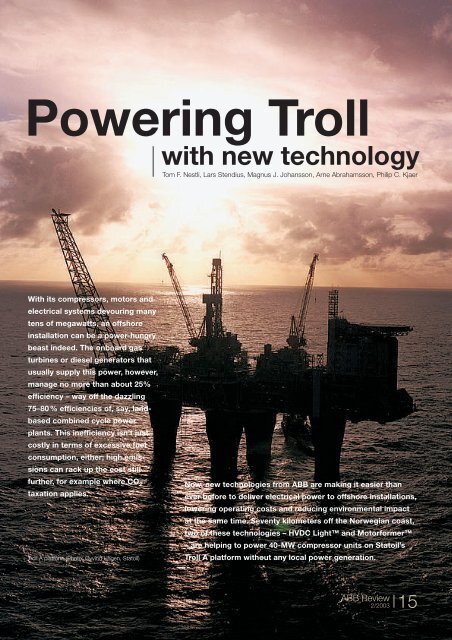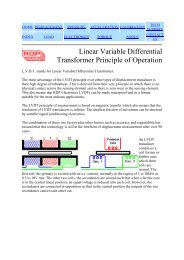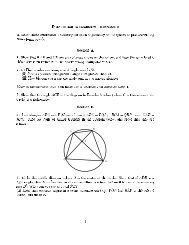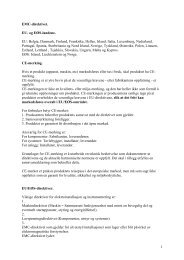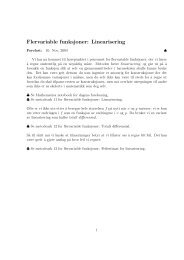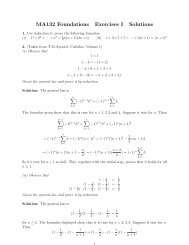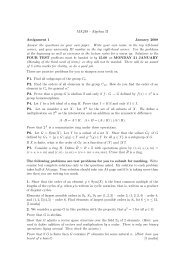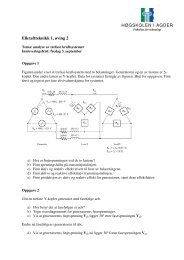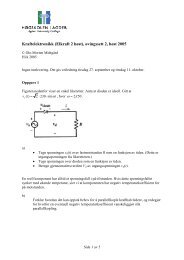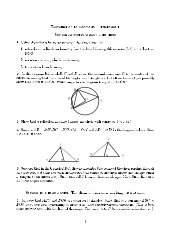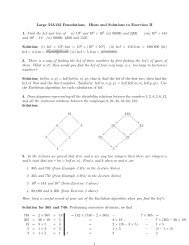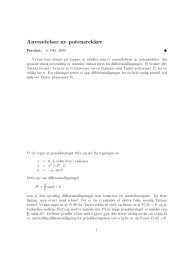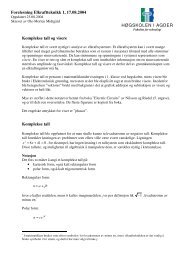Powering Troll - Of the Clux
Powering Troll - Of the Clux
Powering Troll - Of the Clux
You also want an ePaper? Increase the reach of your titles
YUMPU automatically turns print PDFs into web optimized ePapers that Google loves.
<strong>Powering</strong> <strong>Troll</strong><br />
with new technology<br />
Tom F. Nestli, Lars Stendius, Magnus J. Johansson, Arne Abrahamsson, Philip C. Kjaer<br />
With its compressors, motors and<br />
electrical systems devouring many<br />
tens of megawatts, an offshore<br />
installation can be a power-hungry<br />
beast indeed. The onboard gas<br />
turbines or diesel generators that<br />
usually supply this power, however,<br />
manage no more than about 25%<br />
efficiency – way off <strong>the</strong> dazzling<br />
75–80% efficiencies of, say, landbased<br />
combined cycle power<br />
plants. This inefficiency isn’t just<br />
costly in terms of excessive fuel<br />
consumption, ei<strong>the</strong>r; high emissions<br />
can rack up <strong>the</strong> cost still<br />
fur<strong>the</strong>r, for example where CO 2<br />
taxation applies.<br />
<strong>Troll</strong> A platform (Photo: Øyvind Hagen, Statoil)<br />
Now, new technologies from ABB are making it easier than<br />
ever before to deliver electrical power to offshore installations,<br />
lowering operating costs and reducing environmental impact<br />
at <strong>the</strong> same time. Seventy kilometers off <strong>the</strong> Norwegian coast,<br />
two of <strong>the</strong>se technologies – HVDC Light and Motorformer<br />
– are helping to power 40-MW compressor units on Statoil’s<br />
<strong>Troll</strong> A platform without any local power generation.<br />
ABB Review<br />
2/2003<br />
15
On most offshore installations, <strong>the</strong><br />
power generators and large compressors<br />
are driven by onboard gas turbines<br />
or diesel engines with total efficiencies<br />
that can be as low as 20–25 %<br />
even under ideal conditions. As a result,<br />
fuel consumption and CO 2 emissions are<br />
unnecessarily high. Ever since <strong>the</strong> Kyoto<br />
Protocol, which allows trading of greenhouse<br />
gas emissions, high CO 2 emissions<br />
A conventional precompression<br />
project, with gas turbines, would<br />
have resulted in annual emissions<br />
of some 230,000 tons of CO 2<br />
and 230 tons of NO x<br />
.<br />
have become a cost factor. On top of<br />
this, as on <strong>the</strong> Norwegian shelf, <strong>the</strong>re<br />
may be CO 2 taxation, making emissions<br />
costly even without trading.<br />
If <strong>the</strong> electrical power for all this equipment<br />
can be supplied from shore, <strong>the</strong><br />
CO 2 emissions of offshore installations<br />
are eliminated, saving operators a con-<br />
siderable sum of money. But<br />
that isn’t all; transmitting electrical<br />
energy from shore is also<br />
more efficient in terms of<br />
equipment maintenance, lifetime<br />
and availability.<br />
The overall environmental<br />
bonus of eliminating low-efficiency<br />
offshore power plants is<br />
considerable. A landbased<br />
combined cycle<br />
gas power plant,<br />
which utilizes <strong>the</strong> gas<br />
turbine’s waste heat,<br />
can have an efficiency<br />
of as much as 75 to<br />
80 %. Even if high losses<br />
of 10 % are assumed<br />
for a long transmission line to an offshore<br />
installation, <strong>the</strong> saving will still<br />
be significant for most installations.<br />
HVDC Light and Motorformer join<br />
<strong>the</strong> offshore club<br />
<strong>Troll</strong> A is <strong>the</strong> largest gas production<br />
platform on <strong>the</strong> Norwegian shelf. Some<br />
40% of Norway’s total annual gas<br />
production comes<br />
from <strong>Troll</strong> A,<br />
which can produce<br />
up to 100<br />
million cubic<br />
meters of gas per<br />
day. Today, <strong>the</strong><br />
reservoir pressure<br />
drives <strong>the</strong><br />
gas to <strong>the</strong> onshore<br />
processing plant at<br />
Kollsnes, where <strong>the</strong> condensate,<br />
water and gas are<br />
separated. The gas is <strong>the</strong>n compressed<br />
and transported through pipelines to<br />
<strong>the</strong> European continent 1 .<br />
As <strong>the</strong> gas is taken out of <strong>the</strong> reservoir,<br />
<strong>the</strong> pressure inevitably decreases. This<br />
means that to maintain production<br />
capacity, offshore precompression of<br />
<strong>the</strong> gas will eventually become necessary.<br />
ABB has been awarded two contracts<br />
as part of Statoil’s <strong>Troll</strong> A Precompression<br />
Project: a US$ 185 million<br />
contract for <strong>the</strong> compression equipment<br />
and a US$ 85 million contract for <strong>the</strong><br />
electric drive systems for compressors.<br />
1<br />
Gas from <strong>Troll</strong> A is processed at Kollsnes before being transported to <strong>the</strong> European continent.<br />
16<br />
ABB Review<br />
2/2003
2<br />
From <strong>the</strong> rectifier station at Kollsnes, subsea HVDC cables transmit power to <strong>the</strong> <strong>Troll</strong> A Platform, where <strong>the</strong> inverter station and Motorformer<br />
are located. Two identical systems are to be installed.<br />
Kollsnes<br />
Subsea<br />
cable<br />
<strong>Troll</strong> A platform<br />
132-kV switchboard<br />
Rectifier station<br />
HVDC Light<br />
cable<br />
Inverter station<br />
Motorformer<br />
Precompressor<br />
Power<br />
transformer<br />
HVDC Light<br />
rectifier<br />
70 km<br />
HVDC Light<br />
inverter<br />
40 MW<br />
56 kV<br />
Gear<br />
The new installation is due to go into<br />
commercial operation in <strong>the</strong> fall of 2005<br />
as part of a program introduced to<br />
maintain and expand <strong>the</strong> platform’s production<br />
capacity.<br />
Choosing conventional systems for this<br />
project would have meant that gas turbines<br />
would drive <strong>the</strong> compressors. In<br />
that case, it is estimated, annual emissions<br />
of some 230,000 tons of CO 2 and<br />
HVDC Light<br />
In <strong>the</strong> past, high-voltage DC links have been<br />
used almost exclusively to transmit very high<br />
powers over long distances. HVDC Light [1]<br />
is a new transmission technology based on<br />
voltage source converters that extends <strong>the</strong><br />
economical power range of HVDC transmission<br />
down to just a few megawatts.<br />
HVDC Light also offers power quality<br />
improvements, for example reactive power<br />
compensation and harmonic/flicker compensation.<br />
Thanks to fast vector control,<br />
active and reactive power can be controlled<br />
independently, with harmonics kept low,<br />
even in weak grids.<br />
230 tons of NO x would result. Besides<br />
<strong>the</strong>ir impact on <strong>the</strong> environment, <strong>the</strong><br />
CO 2 taxation in effect on <strong>the</strong> Norwegian<br />
shelf means that such emissions<br />
would also be a significant cost factor.<br />
Working with Statoil, ABB developed<br />
an alternative system 2 based on two<br />
innovative ABB technologies – HVDC<br />
Light and Motorformer. These have<br />
been successfully employed on shore<br />
since 1997 and 1998, respectively, but<br />
never before on an offshore installation<br />
or toge<strong>the</strong>r as an electric drive system.<br />
The system uses power from <strong>the</strong> onshore<br />
electrical grid to drive <strong>the</strong> compressors<br />
on <strong>Troll</strong> A, thus eliminating<br />
greenhouse gas emissions from <strong>the</strong><br />
platform.<br />
HVDC Light – rectifying, inverting<br />
and controlling<br />
HVDC Light [1], by using series-connected<br />
power transistors, enables voltage<br />
source converters to be connected to<br />
networks, at voltage levels higher than<br />
ever before, for power transmission,<br />
reactive power compensation and harmonic/flicker<br />
compensation.<br />
On <strong>Troll</strong> A, an HVDC Light converter<br />
(inverter) feeds <strong>the</strong> variable-speed synchronous<br />
machine driving each com-<br />
pressor with AC power obtained by<br />
converting <strong>the</strong> incoming DC, which is<br />
transmitted from shore over submarine<br />
cables. As <strong>the</strong>ir speed is variable, <strong>the</strong><br />
compressors are supplied with power at<br />
variable frequency and voltage, right<br />
through from zero to maximum speed<br />
(at 63 Hz) and from zero to maximum<br />
voltage (56 kV), including starting, acceleration<br />
and braking. The drive systems<br />
perform equally well at each end<br />
Motorformer<br />
Motorformer [2] features conventional rotor,<br />
exciter, control and protection technologies.<br />
Most of <strong>the</strong> stator technology is also conventional<br />
– <strong>the</strong> exception is <strong>the</strong> winding, which is<br />
made of XLPE-insulated cable. The stator’s<br />
cable slots are designed for low electrical<br />
losses, high-strength cable clamping,<br />
efficient cooling and simple installation.<br />
The first Motorformer to go into commercial<br />
operation, at <strong>the</strong> AGA plant in Sweden,<br />
has verified <strong>the</strong> many benefits of using HV<br />
cable technology in large electric motors.<br />
Motorformer is suitable for most applications<br />
where conventional technology is used today.<br />
ABB Review<br />
2/2003<br />
17
3<br />
HVDC Light extruded<br />
submarine cable, with double<br />
armoring (80 kV rating)<br />
of <strong>the</strong> frequency spectrum. Small filters<br />
at <strong>the</strong> converters’ outputs keep <strong>the</strong> motor<br />
winding stress at a safe level.<br />
The inverter control software is adapted<br />
for both motor speed and torque<br />
control. The motor currents and voltages<br />
and <strong>the</strong> rotor position are measured<br />
and used toge<strong>the</strong>r with an advanced<br />
model of <strong>the</strong> machine’s electromagnetic<br />
parameters to calculate converter<br />
switching pulses in much <strong>the</strong><br />
same way as for smaller industrial variable-speed<br />
drives (ACS 600/ACS<br />
1000/ACS 6000). Unity power factor<br />
and low harmonics are assured, along<br />
with a sufficiently high dynamic response,<br />
over <strong>the</strong> motor’s entire operating<br />
range. Protection and monitoring of<br />
<strong>the</strong> converters and synchronous machines,<br />
as well as control of <strong>the</strong> excitation<br />
converter feeding <strong>the</strong> latters’ field<br />
winding, are handled by ABB’s wellproven<br />
Industrial IT HVDC Control,<br />
MACH 2.<br />
Overall control of <strong>the</strong> rectifier station at<br />
Kollsnes is also handled by <strong>the</strong> MACH 2.<br />
There is no need for communication between<br />
<strong>the</strong> rectifier control system on<br />
land and <strong>the</strong> motor control system on<br />
<strong>the</strong> platform; <strong>the</strong> only quantity that can<br />
be detected at each end of <strong>the</strong> transmission<br />
system is <strong>the</strong> DC link voltage. As<br />
<strong>the</strong> DC link cannot store much energy,<br />
<strong>the</strong> motor control system is designed to<br />
follow even rapid changes in power<br />
flow at <strong>the</strong> opposite end without disturbing<br />
motor operation. Nuisance tripping<br />
is generally kept to a minimum.<br />
The HVDC Light converter for <strong>Troll</strong> is<br />
based on a two-level bridge with<br />
grounded midpoint. Only extremely low<br />
ground currents are induced during<br />
steady state and dynamic operation, this<br />
feature being one of <strong>the</strong> main reasons<br />
for using HVDC for <strong>the</strong> power supply.<br />
No cathode protection of any kind has<br />
to be provided for this installation.<br />
HVDC Light cable – <strong>the</strong> power carrier<br />
The HVDC Light concept includes a fur<strong>the</strong>r<br />
innovation: <strong>the</strong> HVDC Light extruded<br />
polymer cable. The shift in high-voltage<br />
AC technology from paper-insulated<br />
to extruded polymer cable was <strong>the</strong> incentive<br />
for ABB to develop and produce<br />
an extruded cable offering <strong>the</strong> same<br />
benefits – flexibility and cost-effectiveness<br />
– for HVDC transmission.<br />
<strong>Troll</strong> A’s importance as a major gas producer<br />
called for an extremely reliable<br />
transmission link. The actual cable has<br />
a 300-mm 2 copper conductor surrounded<br />
by a very strong and robust polymeric<br />
insulating material 3 . Water<br />
ingress is prevented by a seamless layer<br />
of extruded lead, over which <strong>the</strong>re are<br />
two layers of armor – steel wire woven<br />
in counter helix – to provide <strong>the</strong> required<br />
mechanical properties. This design<br />
ensures that <strong>the</strong> cable has <strong>the</strong><br />
strength and flexibility necessary for<br />
laying in <strong>the</strong> North Sea. The two electric<br />
drive systems require an HVDC<br />
Light cable system with two cable pairs<br />
(one for each drive), physically separated<br />
from each o<strong>the</strong>r on <strong>the</strong> sea floor.<br />
The two cables in each pair are operated<br />
in bipolar mode, one having a positive<br />
and <strong>the</strong> o<strong>the</strong>r a negative polarity.<br />
To make sure that <strong>the</strong> cables will not<br />
be damaged by anchors or trawling,<br />
<strong>the</strong>y are laid in trenches on <strong>the</strong> sea bed<br />
4<br />
Input<br />
power<br />
Use of Motorformer TM eliminates<br />
transformer losses (A). Only motor<br />
losses (B) remain.<br />
Conventional<br />
system<br />
A<br />
B<br />
Motorformer<br />
system<br />
B<br />
Shaft<br />
power<br />
formed by water jetting, or covered<br />
with rocks where this is not practicable.<br />
Motorformer drives <strong>the</strong> compressors<br />
Following <strong>the</strong> introduction in 1998 of<br />
new, innovative cable winding technology,<br />
ABB’s engineers soon began to consider<br />
<strong>the</strong> possibility of using HV cable<br />
windings in place of conventional windings<br />
in electrical motors in order to radically<br />
increase <strong>the</strong> motors’ voltage ratings.<br />
Such a motor can <strong>the</strong>n be connected<br />
directly to <strong>the</strong> HV grid, doing away with<br />
<strong>the</strong> need for a costly step-down transformer.<br />
The first product to be based on this<br />
principle was an HV cable-wound generator.<br />
Shortly afterwards, <strong>the</strong> same<br />
concept was applied to motors, resulting<br />
18<br />
ABB Review<br />
2/2003
in <strong>the</strong> development of a synchronous<br />
machine, dubbed Motorformer (see<br />
panel on page 17). The first unit was installed<br />
in 2001 at an air separation plant<br />
in Sweden, where it drives a compressor.<br />
This motor is directly connected to a<br />
42-kV bus. In <strong>the</strong> meantime, ABB offers<br />
HV motors of this kind for voltages up<br />
to 70 kV. Work is currently under way to<br />
develop units rated at 150 kV.<br />
Apart from eliminating <strong>the</strong> step-down<br />
transformer and related switchgear,<br />
Motorformer reduces <strong>the</strong> total system<br />
losses by as much as 25% 4 . Being<br />
epoxy-free, it also has important environmental<br />
benefits, including easy recyclability.<br />
And fewer components mean<br />
higher system reliability and availability,<br />
plus reduced costs for service, maintenance<br />
and spares.<br />
A challenging environment for<br />
high-voltage equipment<br />
<strong>Of</strong>fshore equipment design is constrained<br />
by <strong>the</strong> need to keep both footprint<br />
and weight to a minimum. HVDC<br />
Light and Motorformer offer important<br />
advantages in precisely <strong>the</strong>se areas:<br />
Smaller filters and <strong>the</strong> absence of synchronous<br />
condensers make HVDC<br />
Light more compact and lighter than<br />
traditional HVDC systems.<br />
No large, heavy transformer is required<br />
to connect <strong>the</strong> Motorformer to<br />
<strong>the</strong> HVDC Light converter.<br />
O<strong>the</strong>r design considerations in connection<br />
with this project were:<br />
Safety: <strong>Troll</strong> A produces large quantities<br />
of hydrocarbon<br />
gas, which<br />
is not allowed<br />
to<br />
come into<br />
contact with<br />
high-voltage<br />
equipment.<br />
Environment: The high-voltage equipment<br />
must be protected from <strong>the</strong><br />
damp, salt-laden sea air.<br />
Availability: Given <strong>the</strong> daily production<br />
of gas worth US$ 10-15 million, high<br />
equipment availability is essential.<br />
HVDC Light and Motorformer are innovative<br />
technologies with all <strong>the</strong> qualities<br />
needed to power offshore platforms<br />
from shore for maximum economical<br />
and environmental benefit. <strong>Troll</strong> A is<br />
<strong>the</strong> first such platform anywhere to be<br />
powered in this way, <strong>the</strong> electric drive<br />
system being<br />
part of a<br />
program to<br />
maintain<br />
and expand<br />
production<br />
capacity.<br />
The elimination<br />
of<br />
CO 2 emissions and a smaller equipment<br />
footprint are just two of <strong>the</strong> benefits enjoyed<br />
by Statoil as a result.<br />
HVDC Light TM and<br />
Motorformer TM ensure a small<br />
footprint and low weight –<br />
two essential characteristics<br />
for offshore equipment.<br />
Dr. Tom F. Nestli<br />
ABB / Norway<br />
tom.f.nestli@no.abb.com<br />
Lars Stendius<br />
Magnus J. Johansson<br />
Arne Abrahamsson<br />
Dr. Philip C. Kjaer<br />
ABB / Sweden<br />
[1] G. Asplund, K. Eriksson, K. Svensson: HVDC Light – DC transmission based on voltage sourced converters. ABB Review 1/1998, 4–9.<br />
[2] G. L. Eriksson: Motorformer – A new motor for direct HV connection. ABB Review 1/2001, 22–25.<br />
ABB Review<br />
2/2003<br />
19


